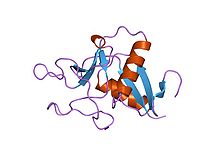- MAPEG family
-
MAPEG family 
Structure of human lithostathine, the pancreatic inhibitor of stone formation.[1] Identifiers Symbol MAPEG Pfam PF01124 InterPro IPR001129 PROSITE PDOC00999 SCOP 1iit OPM family 199 OPM protein 2h8a Available protein structures: Pfam structures PDB RCSB PDB; PDBe PDBsum structure summary MAPEG (Membrane-Associated Proteins in Eicosanoid and Glutathione metabolism) family of transmembrane proteins with highly divergent functions [2]. Included are the 5-lipoxygenase-activating protein (gene FLAP), leukotriene C4 synthase (EC 2.5.1.37), which catalyzes the production of leukotriene C4 (LTC4) from leukotriene A4 (LTA4), and microsomal glutathione S-transferase II (EC 2.5.1.18) (GST-II), which also produces LTC4 from LTA4.
Another example is prostaglandin E synthase. This enzyme catalyses the synthesis of PGE2 from PGH2 (produced by cyclooxygenase from arachidonic acid). Because of structural similarities in the active sites of FLAP, LTC4 synthase, and PGE synthase, substrates for each enzyme can compete with one another and modulate synthetic activity.
Subfamilies
- 5-lipoxygenase-activating protein IPR001446
Human proteins containing this domain
References
- ^ Bertrand JA, Pignol D, Bernard JP, Verdier JM, Dagorn JC, Fontecilla-Camps JC (June 1996). "Crystal structure of human lithostathine, the pancreatic inhibitor of stone formation". EMBO J. 15 (11): 2678–84. PMC 450203. PMID 8654365. http://www.pubmedcentral.nih.gov/articlerender.fcgi?tool=pmcentrez&artid=450203.
- ^ Persson B, Jakobsson PJ, Morgenstern R, Mancini J, Ford-Hutchinson A (1999). "Common structural features of MAPEG -- a widespread superfamily of membrane-associated proteins with highly divergent functions in eicosanoid and glutathione metabolism". Protein Sci. 8 (3): 689–692. doi:10.1110/ps.8.3.689. PMC 2144274. PMID 10091672. http://www.pubmedcentral.nih.gov/articlerender.fcgi?tool=pmcentrez&artid=2144274.
This article includes text from the public domain Pfam and InterPro IPR001129
Categories:- Protein domains
- Protein families
- Transmembrane proteins
Wikimedia Foundation. 2010.
